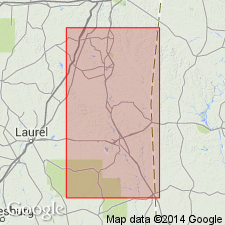
- Usage in publication:
-
- Bucatunna clay member
- Modifications:
-
- Named
- Dominant lithology:
-
- Clay
- AAPG geologic province:
-
- Mid-Gulf Coast basin
Summary:
Bucatunna member of Catahoula group named. Consists of cross-bedded sands, clays, bentonitic clays and bentonite, sparingly fossiliferous, forming basal 20 to 55 ft of Catahoula group (Miocene) in Clarke and Wayne Cos., MS. Rests unconformably on Byram marl and older formations of Vicksburg group. Underlies Lower Chickasawhay member of Catahoula group. Type locality along Bucatunna Creek north of Denham Post Office. Provisionally assigned to the Miocene. Marine, in part.
Source: GNU records (USGS DDS-6; Reston GNULEX).
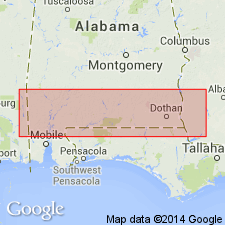
- Usage in publication:
-
- Bucatunna clay member*
- Modifications:
-
- Revised
- AAPG geologic province:
-
- Mid-Gulf Coast basin
Summary:
Chickasawhay marl and Bucatunna clay of Blanpied (1934) accepted as members of Byram marl of Vicksburg group (Oligocene).
Source: GNU records (USGS DDS-6; Reston GNULEX).
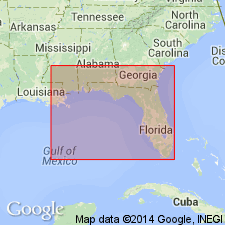
- Usage in publication:
-
- Bucatunna clay member
- Modifications:
-
- Overview
- AAPG geologic province:
-
- Mid-Gulf Coast basin
Summary:
Buccatunna clay is uppermost member of Byram formation. Unconformably overlies and in some areas grades into unnamed marl member. Underlies Chickasawhay limestone. Near Leaf River, MS, cuts out or is overlapped by Catahoula sandstone. Thickness 11 to 55 ft.
Source: GNU records (USGS DDS-6; Reston GNULEX).
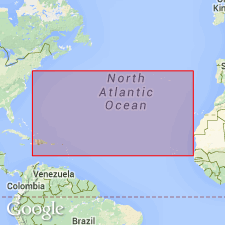
- Usage in publication:
-
- Bucatunna Clay Member*
- Modifications:
-
- Age modified
- AAPG geologic province:
-
- Mid-Gulf Coast basin
Summary:
Age of Vicksburg Group changed from middle Oligocene to early Oligocene. Age of units within Vicksburg changed by inference.
Source: GNU records (USGS DDS-6; Reston GNULEX).
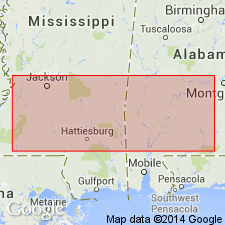
- Usage in publication:
-
- Bucatunna Formation*
- Modifications:
-
- Revised
- AAPG geologic province:
-
- Mid-Gulf Coast basin
Summary:
Unit raised in rank from Bucatunna Clay Member of Byram Formation of Vicksburg Group to Bucatunna Formation of Vicksburg Group. Overlies Byram Formation of Vicksburg; underlies Chickasawhay Formation.
Source: GNU records (USGS DDS-6; Reston GNULEX).
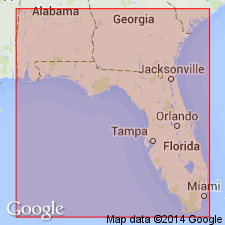
- Usage in publication:
-
- Bucatunna Formation*
- Modifications:
-
- Areal extent
- AAPG geologic province:
-
- Mid-Gulf Coast basin
Summary:
Oligocene Bucatunna Formation geographically extended from western AL to FL panhandle in subsurface. Overlies Byram Formation and is equivalent to or overlies Suwannee Limestone; underlies Chickasawhay Formation.
Source: GNU records (USGS DDS-6; Reston GNULEX).
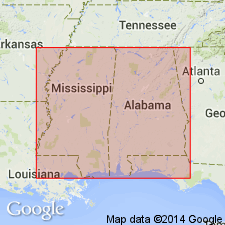
- Usage in publication:
-
- Bucatunna Clay Member, Clay
- Modifications:
-
- Overview
- AAPG geologic province:
-
- Mid-Gulf Coast basin
Summary:
In AL, the Byram Formation overlies the Marianna Limestone and includes the Glendon Limestone Member, an informal unnamed marl member (referred to in this report as the "Byram marl"), and the Bucatunna Clay Member. In MS, the Glendon and the Bucatunna are used at formation rank and the "Byram marl" becomes the Byram Formation. The Bucatunna conformably and gradationally overlies the Byram throughout most of the study area and they are, in part, facies equivalents. In vicinity of Waynesboro, Wayne Co., MS, the Waynesboro sand lentil (informal) of the Bucatunna Clay, cuts out the underlying clays and marl and disconformably overlies either the Glendon or the Marianna Limestone. This channel-fill deposit consists of very fine to fine-grained, subangular, cross-bedded sand and silt and is approximately 100 ft thick near Waynesboro. In the type area, the Bucatunna generally consists of 20 to 55 ft of light- to dark-gray, laminated, silty to arenaceous, micaceous, carbonaceous, fossiliferous clay with some interbeds of sand and bentonitic clay in outcrop. In the subsurface the unit attains thicknesses of greater than 100 ft. Bucatunna has been recognized from Covington Co., AL, westward to Warren Co., MS.
Source: GNU records (USGS DDS-6; Reston GNULEX).
For more information, please contact Nancy Stamm, Geologic Names Committee Secretary.
Asterisk (*) indicates published by U.S. Geological Survey authors.
"No current usage" (†) implies that a name has been abandoned or has fallen into disuse. Former usage and, if known, replacement name given in parentheses ( ).
Slash (/) indicates name conflicts with nomenclatural guidelines (CSN, 1933; ACSN, 1961, 1970; NACSN, 1983, 2005, 2021). May be explained within brackets ([ ]).

